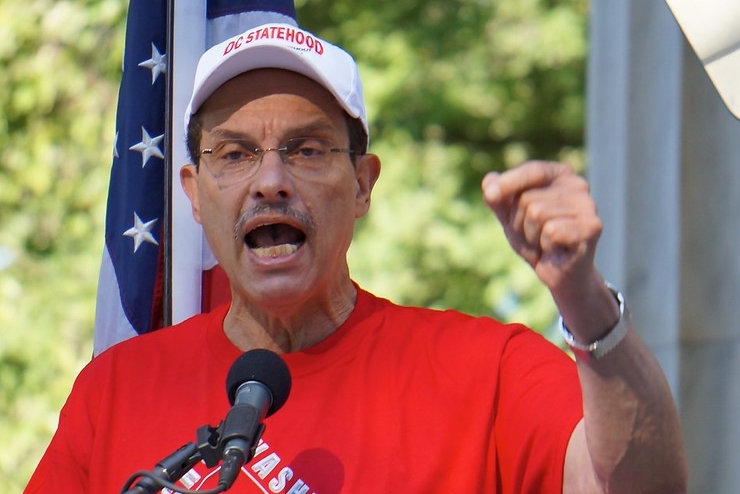“How many legs does a dog have if you call his tail a leg?” asked President Abraham Lincoln, who answered his own question: “Four. Saying that a tail is a leg doesn’t make it a leg.” And Congress’ saying that D.C. is a state would equally contradict truth and reality, as our nation’s capital lacks all of the attributes of a 51st state of the Union. Whence came our capital of Washington, D.C.?
The city was carved out of Maryland and Virginia in 1790, which voted to cede 100 square miles on the Potomac for a capital city of the United States to become the domicile of the federal government. In 1846, Virginia’s share of the land, some 32 square miles, was ceded back. What was left was today’s Washington, D.C., of 68 square miles. Is that sufficient for a state of the Union? Only if one wishes to change the character and composition of that Union.
Consider. The smallest state for 230 years has been Rhode Island. At 1,214 square miles, it is still 18 times as large as D.C. If D.C. were to become a state, it would be a microstate, smaller than every one of the 24 remaining counties of the state, Maryland, from which it was carved. The Maryland counties that border D.C., Montgomery, and Prince George’s, are eight times the size of Washington, D.C., and each has a million people, dwarfing the 700,000 residents of D.C. Directly across the Potomac in Virginia is Fairfax County, also eight times as large as D.C., and with hundreds of thousands more people.
Supporters of statehood say D.C. has more people than Wyoming. True, but Wyoming is also roughly the size of the United Kingdom, and more than 1,000 times the size of Washington, D.C.
Even by the standards of American cities, Washington ranks no higher than 20th in population. Texas—with Houston, Dallas, San Antonio, and Fort Worth—and California—with Los Angeles, San Jose, San Diego, and San Francisco—both have four cities larger and more populous than our aspiring city-state of D.C.
By the terms of its admission to the United States as a state, the Republic of Texas was ceded a right to split into as many as five states of the Union, which it was joining. FDR’s future vice president, the Texan John Nance “Cactus Jack” Garner, was all for it. “An area twice as large and rapidly becoming as populous as New England should have at least ten Senators,” Garner told The New York Times in April 1921, “and the only way we can get them is to make five States, not five small States, mind you, but five great States.”
Statehood for little D.C. could start a trend where mega-cities like Chicago and New York, with five and 10 times the size and population of D.C., secede from their respective states and seek full statehood as well.
What is at the root of this drive to make D.C. a state? The answer may be found in the political character of our capital city. Since the 23rd Amendment was ratified, 60 years ago, D.C. residents have voted in 15 presidential elections. In all 15 elections, D.C.’s three electoral votes have gone to the Democratic nominee. Even in the 49-state Nixon and Reagan landslides of 1972 and 1984, D.C. went four- and five-to-one Democratic. In eight presidential elections since 1990, the GOP nominee has failed to win 10 percent of the D.C. vote. Since the mid-1970s, D.C. has had home rule and, in every election since, has chosen a Democratic mayor and a Democratic city council.
How irredeemably Democratic is D.C.? Voter registration statistics in the city as of last December was 403,000 Democrats and 30,000 Republicans, a ratio of 13-1.
Which brings the question: What is D.C.’s grievance that America must somehow rectify by making it a state? Answer: Democrats want D.C. to have two senators to cement their control of the U.S. Senate, as they pack the Supreme Court by expanding the number of justices from nine to 13.
This is a naked national power grab—pure and simple. If the real concern were the inability of the D.C. electorate to vote for members of Congress, that could be remedied—by returning the residential portions of D.C. to Maryland, whence they came, or by allowing D.C. residents to vote in Maryland’s congressional elections.
Making D.C. a state would send two Democrats to the Senate indefinitely. But it would violate the constitution and compact under which the nation was founded. And it would start a stampede for other disfiguring alterations, like packing the Supreme Court by adding four new justices. Puerto Rico, the U.S. Virgin Islands, the Northern Mariana Islands, Guam, and American Samoa could soon follow and enter claims to become states of the American Union. And a second unraveling of the republic would begin.
COPYRIGHT 2021 CREATORS.COM
Image Credit:
above: DC mayor Vincent Gray at a DC statehood rally (Image from: Keith Ivey, CC BY-NC-SA 2.0 , via Flickr)

Leave a Reply